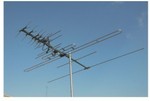Aussie Made VHF/UHF Combination Outdoor TV Antenna $79.50 (1/2 Price) Delivered @ DSE
The Matchmaster Digimatch VHF⁄UHF Combination TV Antenna is a high quality Australian designed and manufactured antenna that is suitable for both analogue and digital television reception. It is designed for wideband reception making it ideal for metropolitan and most country areas around Australia.
For areas such as ACT, Condobolin, Taree, Bundaberg and Shepparton - additional component (L0154) required to mount vertically, where UHF is horizontal and VHF vertically polarised.
The antenna has 30 UHF⁄VHF X-Type Co-linear Elements giving it a wider bandwidth coverage, higher gain and improved VSWR (Volt-Standing Wave Ratio) & Front-to-Back Ratio for superior Carrier to Noise ratio than other existing antenna designs. It is also designed for future UHF allocations plus one networks system, thus future proofing against an early obsolescence.
The antenna has a digital anti-reflecting matching system (DMS) achieved by diplexing the UHF and VHF antennas together, giving 20dB isolation for sharper analogue pictures and better Bit Error Ratio (BER) for digital transmission. A detachable UHF section allows the antenna to be used in Horizontal and Vertical areas as well as Horizontal-Vertical combination areas such as Canberra, Dubbo, Wide Bay and Shepparton.
Finally, the antenna is fitted with an 'F' Type PCB Balun for quick installation and improved VSWR. The VHF elements are constructed from 12.7mm diameter aluminium tubing, lending extra strength against the harsh Australian environment. The strenghtened rectangular boom is powder coated for longevity while all plastic components are constructed from ultraviolet (U⁄V) stabilised and resistant black ABS (Acrylonitrile Butadiene Styrene), a tough plastic that is resistant to heat, impact and chemical stresses.All metal screws are of stainless steel in order to reduce the chances of rusting and corrosion.


Doesn't seem like a good choice, I'm pretty sure analogue/digital TV antennas are worse then just digital antennas.